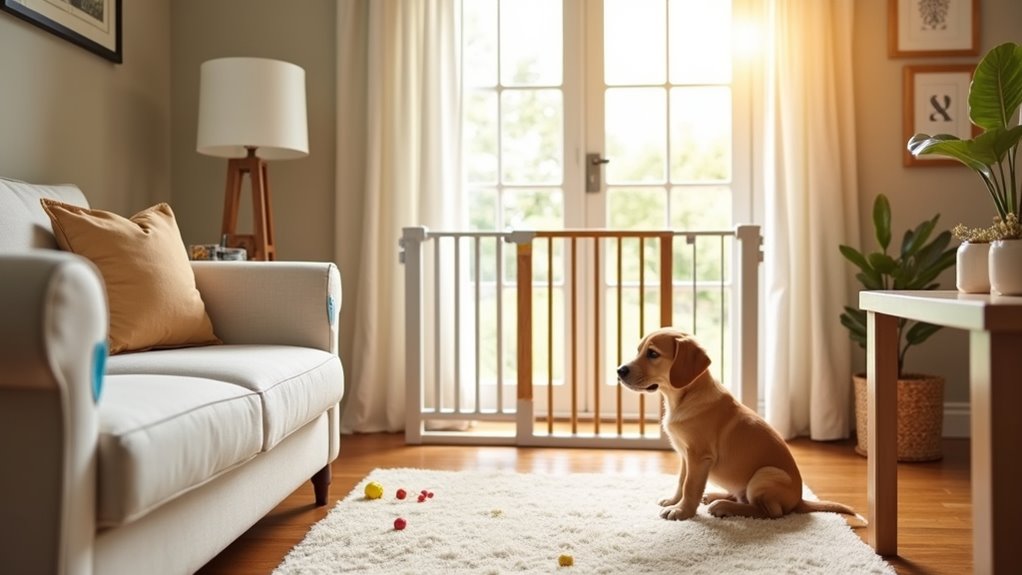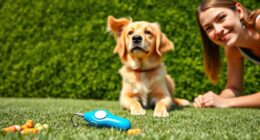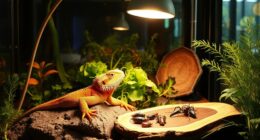To pet-proof your home and create a safe environment, start by removing or relocating toxic plants and securing household chemicals in high, locked cabinets. Clear floors of small items that could cause choking, and store human foods out of your pet’s reach. Protect electrical cords, and keep sharp or unsafe objects away. Regularly check your home for hazards, and stay vigilant as you discover more tips to keep your pets safe and secure.
Key Takeaways
- Remove or relocate toxic plants and ensure plants are out of pets’ reach to prevent ingestion hazards.
- Store household chemicals and medications in high, locked cabinets to avoid accidental poisoning.
- Keep small objects and human foods like chocolate and grapes securely stored away from pets.
- Use cord protectors and hide electrical cords to prevent chewing and electrical injuries.
- Regularly inspect your home for potential hazards and supervise pets, especially new or curious animals.

Have you ever worried about your pet getting into trouble around the house? It’s a common concern, especially when you realize how many everyday items can pose serious risks. Pets are naturally curious, and their instincts often lead them to explore every corner of your home. To keep them safe, you need to pet-proof your environment carefully. Start by inspecting your house for hazardous plants. Many common houseplants, like lilies, poinsettias, and philodendrons, are toxic if ingested. Even some outdoor plants can be dangerous if your pet manages to get outside. Removing or relocating these plants to areas out of your pet’s reach is a simple yet effective way to prevent accidental poisoning.
Inspect your home for toxic plants and relocate them to keep your pet safe from accidental poisoning.
Another essential step is securing dangerous chemicals. Household cleaners, insecticides, antifreeze, and certain medications are often stored under sinks or in cabinets where pets can access them easily. Always keep these items in high, locked cabinets or in containers that pets can’t open. Remember, even small amounts of toxic chemicals can cause severe health issues or worse. It’s wise to regularly check that all chemicals and medications are tightly sealed and stored safely away from curious noses and paws.
In addition, be cautious about what you keep within your pet’s reach. Small objects like rubber bands, paper clips, and string can be ingested and cause choking or intestinal blockages. Check your floors and countertops regularly to clear away any items that could be dangerous if swallowed. Also, watch out for food items that are safe for humans but toxic to animals, such as chocolate, grapes, onions, and certain nuts. Store food securely and never leave leftovers unattended on counters or tables. To prevent accidental ingestion, consider secure food storage in a designated area inaccessible to pets.
Electrical cords also pose a hazard. Pets may chew on them, risking electrocution or burns. Use cord protectors or hide cords behind furniture, and discourage your pet from chewing on them by providing appropriate toys. Similarly, keep small or sharp objects, like scissors or needles, out of reach. Regularly scan your home for objects that could injure your pet and remove them immediately. Additionally, understanding the importance of color accuracy and how it can affect your pet-proofing efforts may help you recognize potential hazards that could be visually misleading or confusing for your pet. Remember that neurological responses in animals can sometimes cause unexpected behaviors, so observing their reactions can be crucial.
Creating a safe environment isn’t a one-time task; it’s an ongoing process. Keep your home secure by routinely checking for hazards, especially if you’re bringing a new pet into your space. When you’re vigilant about hazardous plants, dangerous chemicals, and other potential dangers, you greatly reduce the risk of accidents. Your pet’s curiosity is adorable, but it’s your responsibility to ensure that their explorations don’t lead to harm. By making these adjustments, you’ll create a safer home where your furry friend can explore and thrive without worry. Additionally, familiarizing yourself with expert advice on pet safety can provide valuable insights and tips to further enhance your pet-proofing efforts.
Frequently Asked Questions
How Can I Pet-Proof a Multi-Story Home Effectively?
To pet-proof a multi-story home effectively, focus on multi-level safety by securing stairways with sturdy stair gate installation. You should also keep hazards like cords, small objects, and toxic plants out of reach. Regularly check for loose railings or gaps that could cause falls. Creating designated safe zones and using non-slip mats on stairs helps prevent accidents, ensuring your pet stays safe across all levels of your home.
Are There Specific Plants I Should Avoid Around Pets?
You should avoid plants with indoor plant dangers like lilies, azaleas, and sago palms, as they’re toxic to pets. Learn to identify toxic plants through proper toxic plant identification to prevent accidental ingestion. Keep these harmful plants out of your home or secure them where your pets can’t access. Staying informed about which plants pose risks helps guarantee your furry friends stay safe and healthy.
What’s the Best Way to Secure Trash Cans From Pets?
You know what they say, a locked trash can keeps trouble at bay. To guarantee trash can safety, use secure, lidded containers and consider mounting or anchoring them to the wall. Pet proofing tips like these prevent your furry friends from rummaging through garbage and getting into harmful substances. Regularly check for weak spots or loose lids, and always stay a step ahead to keep your pets safe and your home mess-free.
How Do I Pet-Proof Outdoor Furniture and Gardens?
To pet-proof outdoor furniture and gardens, start by avoiding outdoor hazards like sharp tools or toxic plants. Use pet-safe sprays or covers on furniture to prevent chewing, and secure or hide electrical cords. Create a dedicated, shaded garden space with non-toxic plants, and install barriers around garden beds to protect plants and keep pets safe. Regularly check the area for hazards, ensuring your outdoor space remains a secure and inviting environment for your pets.
Which Household Cleaning Products Are Safe for Pets?
When choosing household cleaning products, you should prioritize household chemical safety and opt for pet-friendly cleaning solutions. Look for labels that specify they’re safe for pets, avoiding harsh chemicals like bleach or ammonia. You can also make your own natural cleaners using vinegar, baking soda, or lemon. Always store cleaning supplies out of reach, and guarantee proper ventilation. This keeps your home safe and your furry friends protected.
Conclusion
By pet-proofing your home, you create a safe space where your furry friend can thrive. Imagine a curious cat that sniffs out a loose electrical cord—if it’s hidden or protected, accidents are prevented. Take the time to secure windows, hide cords, and store dangerous items. Your efforts guarantee peace of mind and a happy, healthy pet. After all, a little prevention goes a long way in keeping your beloved animal safe and sound.










